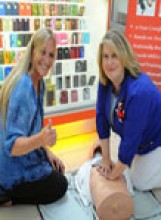Archive for Uncategorized
Jellyfish Stings
Posted by: | CommentsUnlike what you see on movies and television shows, urinating on Jellyfish stings is not the recommend treatment. In fact, urinating upon the site can cause additional stings. Jellyfish stings can cause immediate pain and burning for several hours. Raised, red welts develop along the site of the sting, which may look as if you have been hit with a whip.
Avoid rubbing the affected area with your unprotected hands. The remaining tentacles can attach to your hands and cause additional stings and pain. Don’t flush with fresh water, urine, gasoline or turpentine, this will stimulate the tentacles to release more venom.
It is suggested to use a solution of vinegar and warm water to the site to prevent further stings. If vinegar is not available, flush the effect area with copious amounts of salt water. Pick off the remaining tentacles with a stick or your hand protected by a towel or glove. If it’s available, apply a lather of shaving cream or soap, or a paste of baking soda, flour, or talc, to the skin. The stinging cells will stick to the shaving cream or paste and can then be easily scraped off with the edge of a credit card.
Closely observe the victim for any signs of a serious allergic reaction. Any swelling of the neck, face, tongue, developing hives and skin rashes or difficulty in breathing could be the beginning signs of anaphylactic shock and should be treated by a medical professional immediately.
Dangers of Sneezing
Posted by: | CommentsFor one poor woman it left her paralyzed for almost 2 years. “I was in the shower when I sneezed. The most agonizing pain shot right through me and I fell to the floor. I was by myself at home and my phone was in the bedroom,” says Lauren, a 28-year-old entertainment manager. “I somehow eased myself out of the shower, but must have passed out with the pain because, two hours later, I woke up shivering on the bathroom floor. I was in horrendous pain.” Unfortunately for Lauren the force of her sneeze caused a slipped disc in her back and left her paralyzed for almost 2 years.
Injuries caused from sneezing are more prevalent than you might think. Another woman in Australia dislocated her neck from a sneeze. “I just knew something was wrong. I felt something move and I was in excruciating pain,” said Monique a mother of a 10-year old baby at the time.
Doctors say that these types of heavy trauma are rare due to a sneeze, but many other injuries can occur from this small tickle in your nose. The two types of sneeze that can cause damage are, 1) when a person sneezes so violently the force throws your body out of kilter or 2)a whiplash effect occurs when your head moves forwards and backwards very quickly. These types of sneeze can cause all sorts of muscle strain or bone problems, even broken ribs. Suppressing a sneeze, before letting it out can cause a massive build-up of pressure in our head, which can burst eardrums, tear blood vessels and damage your sinuses. There have even been rare cases of brain hemorrhages. More common injuries are bitten tongues or checks.
When you feel a sneeze coming on tighten your abdominal muscles to protect yourself from any whiplash effects. Align your body into a neutral position, try not to twist or angle your torso. Then sneeze into a napkin, tissue or the sleeve of your arm to prevent your germs from being distributed out to others. A sneeze can produce over 40,000 droplets of moisture and millions of germs. It can spread these germs up to a distance of 32 feet.
Health Threats at Local Ballparks
Posted by: | CommentsDid you order a side of Salmonella? According to a recent ESPN report, several food concession vendors at major ballparks and arenas throughout the US, received at least one or more major health violations. Mold in ice machines at six stands at Miller Park in Milwaukee. A cockroach crawling over a soda dispenser in a private club at Mellon Arena in Pittsburgh. Food service workers repeatedly ignoring orders to wash their hands at a stand at Detroit’s Ford Field.
Improper food care or unsanitary conditions can lead to outbreaks of food-borne illness. Several health inspectors reported slime in the ice machines, food stored at unsafe temperatures and cockroaches in the soda dispensers.
Here is a listed of how our local facilities ranked, best to worst:
AT&T – 4% of vendors in violation
Inspectors found a few incidents of food being stored at improper temperatures.
Candlestick Park – 13% of vendors in violation
Lack of hot water for proper hand washing while handling food.
Oracle Arena – 19% of vendors in violation
Potato salad was left out at unsafe temperatures during game. Then put back in the refrigerator to be reused.
HP Pavilion – 20% of vendors in violation
Chinese chicken salad was warmed to an unsafe temperature. 20% above suggested levels.
Arco Arena – 25% of vendors in violation
Inspectors found shrimp pasta salad being served at an improper temperature.
McAfee Coliseum – 34% of vendors in violation
Several locations were found to lack or have inadequate hand washing stations for vendors who handled food.
Don’t let food poisoning be part of the price of admission. Each vendor must display their health inspection grade with the letter “A” being the best. Your best bet is to patronize these locations.
The 5 Dirtiest Places in Your Home
Posted by: | CommentsKitchen Sink – Would you believe your toilet maybe cleaner than your kitchen sink? Most of us will use a disinfectant cleaner to clean our toilets, whereas, we usually only rinse our sinks with plain water. Left-over food on plates can breed e-coli or salmonella. These germs can easily transfer onto your hands, which then can get into your mouth, eyes or nose, as well as other foods that you may prepare for consumption.
Salt & Pepper Shakers – A University of Virginia study showed that almost all the Salt and Pepper shakers tested showed signs of the cold viruses.
Toothbrush – Most of you just rinse and put away our toothbrush, creating an inviting moist environment for bacteria growth. Also when flushing your toilets, a fine mist is released into the air which can be suspended for up to 2 hours. These fine droplets can fall upon exposed surfaces such as toothbrushes.
TV Remote – Any viruses and bacteria’s you pick up on your hands throughout the day are then deposited unto other surfaces, such as the one used by all family members, the TV remote control. Of all surfaces in your home this one is that contains the most recorded bacteria.
Computer Keyboard – If you eat at your computer, sneeze on your keyboard, or sit down to surf the Internet without first washing your hands, your computer keyboard could be a health hazard. In a recent study by a British consumer group, researchers swabbed keyboards for germs and found a host of potentially harmful bacteria, including E. coli and staph. Four of 33 sampled keyboards had enough germs to be considered health hazards. One had levels of germs five times higher than those found on most toilet seats.
To help control infections and the spread of disease, you may consider regularly cleaning these common household surfaces with a disinfectant or a solution of bleach and water.
Dark Side of Sunscreen
Posted by: | CommentsA recent study by the CDC shows that 97% of all Americans are contaminated with a toxic chemical called oxybenzone (benzophenone-3, BP-3). Oxybenzone is an ingredient found in many of the most popular sunscreens. This chemical is primarily used to absorb UV-ultraviolet rays.
Oxybenzone is a derivative of benzophenone, which is known to attack DNA when illuminated. This organic compound penetrates into the skin and acts as a photosensitizer, where it increases the development of free radicals under illumination.
These free radicals increase the pre-mature aging of the skin while also becoming a photocarcinogen.
A 2006 study by the University of California, “Free Radical Biology and Medicine,” showed that the longer oxybenzone and two other sunscreen chemicals remained on the skin, the
more free radical damage occurred.
“We don’t need to have sunscreens that end up in the blood of a kid,” says Richard Wiles,
co-founder of the Environmental Working Group (EWG), a Washington-based nonprofit. EWG’s researchers say some sunscreens are better than others and operate a database of cosmetic products vetted for potential health hazards. You can look up a specific sunscreen or other products at www.cosmeticsdatabase.com.
Though at first glance this may seem a significant health hazard, Dr. Calafat of the CDC and the senior authors of the CDC study states, “the presence of a chemical in the body, at the levels that we saw, doesn’t mean that chemical is causing adverse health effects.”
Also John Bailey, chief scientist of the Personal Care Products Council, a trade association representing sunscreen and other cosmetic manufacturers says, “these are very, very low levels, below levels that may be showing effects in animal or cell structure testing.
The FDA does not actually test or approve sunscreen products. It lets the industry monitor itself and acts as a penalizing or police force when a health hazard arises, which means that people have already become sick or suffered the ill effects of a product
before any actions are taken.
What we do know is that UV radiation from the sun damages our skin and is the leading cause of skin cancer. Over one million new skin cancers were reported in 2007. It is prudent to wear some sort of protection when performing activities outdoors. The EWG has determined that mineral sunscreens have the best safety profile of today’s choices. They are stable in sunlight and do not appear to penetrate the skin. They offer UVA
protection, which is sorely lacking in most of today’s sunscreen products.
Reference: Health – 418
Recreational Water Illness
Posted by: | CommentsOver the past decade we have seen a steady rise in recreational water illnesses. The main culprits seem to be community pools, hot tubs and water parks. A specific parasite called cryptosporidiosis or crypto for short, can survive in even well chlorinated pools. Crypto, even in small portions, can make a person very ill. It comes from fecal matter especially from diarrhea. Even small amounts of diarrhea can infect an entire pool.
Crypto has a hard shell which makes it especially hard to kill. Even in well-kept bodies of water it can live up to several days. It is most potent amongst people who are already weakened like the elderly or children, although it can affect many people who aren’t unwell. The disease causes diarrhea which drains your body of many of the nutrients that you need to sustain life.
The following recommendations are intended to help prevent and control cryptosporidiosis.
- Practice good hygiene.
- Wash hands with soap and water for at least 20 seconds, rubbing hands together vigorously and scrubbing all surfaces.
- To reduce the risk of disease transmission, children with diarrhea should be excluded from child care settings until the diarrhea has stopped.
- Protect others by not swimming if you are experiencing diarrhea (this is essential for children in diapers).
- If diagnosed with cryptosporidiosis, do not swim for at least 2 weeks after diarrhea stops.
- Shower before entering the water.
- Do not drink pool or hot tub water.
Are You Killing Yourself to Look Beautiful?
Posted by: | CommentsOn average, women uses about 12 beauty products each day. Researchers estimate that in these beauty products there are approximately 120 chemicals present. Some chemicals are good and will cause no harm with their use. While others can be detrimental and increase health problems. Unknowingly many of the products you use every day contain chemicals that have been proven to be carcinogens.
Here are a few that can have an effect on your health:
Lipstick – A recent study by the FDA showed that most lipsticks had lead levels that are higher than those they consider safe for foods you ingest such as candy. The FDA allows candy to have levels of lead that are no higher than 0.1 ppm, Maybelline’s Color Sensational 125 Pink Petal lipstick has lead levels 700 times higher (7.19 ppm). Though Maybelline’s Color Sensational ranked the highest, L’Oreal Colour Riche 410 Volcanic lipstick came in at 7.0 ppm and Cover Girl’s Queen Collection, though much better, still is 400 times higher than the acceptable level at 4.92 ppm.
Lead poisoning has been known to increase memory loss, mood swings and miscarriages. For a full list of products and lead levels here’s a link to the FDA website study: http://www.fda.gov/Cosmetics/ProductandIngredientSafety/ProductInformation/ucm203078.htm
Shampoo – It was recently reported that Johnson & Johnson’s Baby Shampoo contains Formaldehyde, another known carcinogen. The Formaldehyde is said to be used as a preservative though it has been discovered that J&J sells the same shampoo in other countries without this chemical as an ingredient. Update: Johnson & Johnson has also promised to remove such chemicals, and others, from all of its consumer products by 2015, including popular brands like Neutrogena and Clean & Clear. http://www.nytimes.com/2014/01/18/business/johnson-johnson-takes-first-step-in-removal-of-questionable-chemicals-from-products.html?_r=0
Parabens – Found in deodorants can disrupt hormone cycles and wreak havoc on your body.
Endocrine Disrupters – The “endocrine system” manages your hormones. These chemicals can cause chaos leading to reproductive problems, deformities and even cancer. These endocrine disrupters can be found in food packaging, plastics and even in the heat sensitive receipts you get at the gas pump and ATMs.
Start to take notice of the products you are buying. Society does unfortunately put a premium on beauty, but it shouldn’t be at the expense of your health. Try and look for products that don’t contain these harmful chemicals.
12 Reasons To Go To The ER
Posted by: | CommentsAccidents and injuries can occur at any time. Sometimes it may be difficult to determine if injury or symptoms are serious enough for immediate medical attention. Though this is not an all-inclusive list, here are a few general guidelines to help you decide if you should make a trip to the ER?
- Loss of consciousness. Even if only briefly.

- Signs of a Heart Attack – such asdifficulty breathing, chest pressure, numbness in any arm and profuse sweating.
- Signs of a Stroke – Unable to smileon both sides of face, difficulty in raising either arm, speech impairment.
- Shortness of breath.
- Bleeding that doesn’t stop after 10 minutes.
- Poisoning.
- Insect bite or sting where breathing becomes difficult or worsens.
- Major injury, such as a head trauma, dislocation or if bone is showing.
- Coughing up blood.
- Persistent or severe vomiting.
- Suicidal feelings.
- Unexplained disorientation or drowsiness.
In general, if you are questioning whether or not to go to the Emergency Room, it would be best to default on the side of safety and seek immediate medical attention.
Which Public Bathroom Stall to Use?
Posted by: | Comments In a public restroom does it make a difference in which stall you should use? Surprisingly the answer is yes. The center stall has more exposure to the floating droplets of water that are expelled during the flushing process. These droplets can carry germs, urine and feces which land on the toilet seat and handle. You can’t catch an STD from a toilet seat, but you can become ill by touching contaminated surfaces and then neglecting to wash your hands.
In a public restroom does it make a difference in which stall you should use? Surprisingly the answer is yes. The center stall has more exposure to the floating droplets of water that are expelled during the flushing process. These droplets can carry germs, urine and feces which land on the toilet seat and handle. You can’t catch an STD from a toilet seat, but you can become ill by touching contaminated surfaces and then neglecting to wash your hands.
Practice safe hygiene by always washing your hands with soap and water after using the restroom. Use a paper towel when opening the restroom door . Your best bet on the safest stall – select the stall that is the farthest to the left or right, away from the center of the restroom.
Dry Drowning
Posted by: | Comments Dry Drowning is essentially drowning, but without the body of water as the immediate cause. This can happen anywhere from one to 24 hours after having spent time in a pool or other water source.
Dry Drowning is essentially drowning, but without the body of water as the immediate cause. This can happen anywhere from one to 24 hours after having spent time in a pool or other water source.
What happens is a small amount of water is aspirated into the lungs. This water is either absorbed into the bloodstream causing an imbalance of electrolytes, diluting the blood and causing an abnormal heart rhythm, or it prevents the normal absorption of oxygen into the blood system causing either cardiac arrest or possible brain damage.
Approximately 4,000 people die each year from drowning, of these about 10% to 15% can be classified as dry drowning. This is a significant number especially since high percentages are children.
In most cases of dry drowning, a person’s behavior may seem to be quite normal after they have been in the water. But there are a few signs to look for to help identify if there is a potential problem.
A consistent cough that continues for a half hour or more, shortness of breath, pain in the chest, lethargy or a dramatic change in their normal behavior, such as becoming combative or cranky should prompt you to seek immediate medical attention.
Victims of dry drowning have the best chance of survival by being treated at a medical facility. If the victim loses consciousness and stops breathing, immediately call 9-1-1 and begin CPR by compressing the chest 30 times in a row, then deliver 2 rescue ventilation.
Now that summer is here and we begin to spend more time and activities around water, remember the signs to look for concerning dry drowning. It can happen to adults as well as children. If you are not sure, always fault on the side of caution and have the person checked by a physician. Let’s be safe not sorry.







